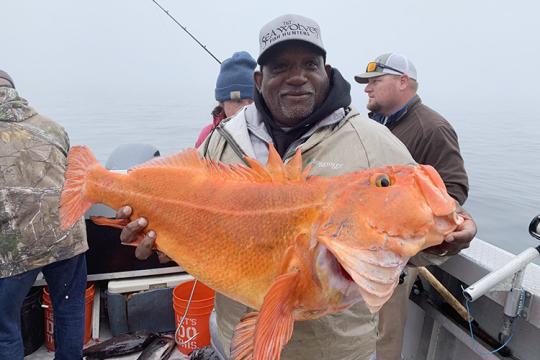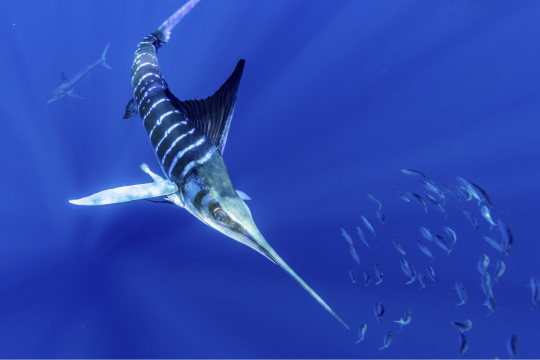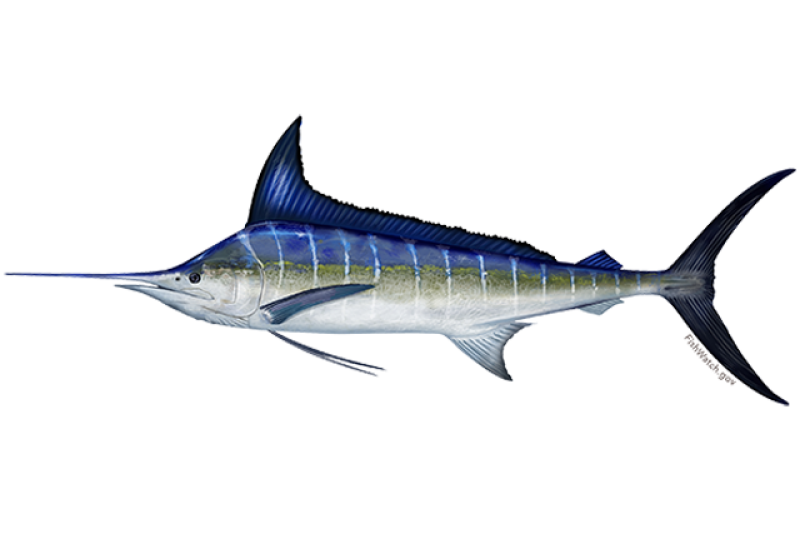 Striped marlin right off the coast of Puerto Carrillo, Costa Rico. Credit: Jackie Mora, CC-SA-3.0
Striped marlin right off the coast of Puerto Carrillo, Costa Rico. Credit: Jackie Mora, CC-SA-3.0
Striped marlin right off the coast of Puerto Carrillo, Costa Rico. Credit: Jackie Mora, CC-SA-3.0
About the Species
 Striped marlin right off the coast of Puerto Carrillo, Costa Rico. Credit: Jackie Mora, CC-SA-3.0
Striped marlin right off the coast of Puerto Carrillo, Costa Rico. Credit: Jackie Mora, CC-SA-3.0
Striped marlin right off the coast of Puerto Carrillo, Costa Rico. Credit: Jackie Mora, CC-SA-3.0
Striped marlin are a highly migratory fish living at the top of the food chain in the tropical and subtropical regions of the Pacific and Indian Oceans. It is a member of a larger family known as billfish, which get their name from their upper jaw that extends to form a spear. Because of their large size, marlin are prized sport fish. Striped marlin also support large commercial fisheries throughout the Pacific Ocean.

Population
The stocks are not overfished.

Fishing Rate
The Eastern Tropical Pacific stock is not subject to overfishing. The Central Western Pacific stock is subject to overfishing. International conservation and management measures are in place to end overfishing for this stock.

Habitat Impact
Gear used to harvest striped marlin rarely contacts the ocean floor, so habitat impacts are minimal.

Bycatch
Regulations are in place to minimize bycatch. Striped marlin are caught incidentally in some fisheries that target tunas and swordfish.
Population Status
- There are two stocks of striped marlin: The Eastern Tropical Pacific and Central Western Pacific stocks. According to the most recent stock assessments:
- The Eastern Tropical Pacific stock is not overfished and not subject to overfishing (2010 stock assessment). Summary stock assessment information can be found on Stock SMART. The Inter-American Tropical Tuna Commission (IATTC) conducted this assessment.
- The Central Western Pacific stock is not overfished - rebuilding, but subject to overfishing (2023 stock assessment). Summary stock assessment information can be found on Stock SMART.
- The Western and Central Pacific Fisheries Commission (WCPFC), of which the United States is a member, has agreed to international conservation and management measures for the Central Western Pacific stock.
- Population assessments for the Central Western Pacific striped marlin stock are conducted by the Billfish Working Group of the International Scientific Committee for Tuna and Tuna-Like Species in the North Pacific Ocean (ISC). NOAA Fisheries scientists participate in the ISC assessments and contribute relevant U.S. fishery data.
Appearance
- Striped marlin are large, oceanic fish with long, round bills, small teeth, and a tall dorsal fin.
- Their bodies are dark blue-black on the top and fade to a silvery white on the bottom.
- They have rows of blue colored stripes made up of smaller round dots or narrow bands.
Biology
- Striped marlin are smaller than other marlin species, but can reach a length of 12 feet and weigh more than 450 pounds.
- Spawning occurs in the central Pacific and off central Mexico.
- Juvenile fish move east toward the coast of Mexico, where they are found in high abundance around the tip of the Baja Peninsula.
- Striped marlin are opportunistic feeders of fish including mackerel, sardine, and anchovy. They will also eat invertebrates, including squid.
- Off the coast of southern California, they often feed at the surface on small coastal fish and squid.
- Large pelagic sharks or toothed whales prey on adult marlin.
Where They Live
Range
Striped marlin live throughout tropical and sub-tropical waters of the Pacific and Indian Oceans.
Habitat
- Striped marlin prefer water temperatures of 20–25˚ C.
- Acoustic telemetry studies indicate that they spend 86 percent of their time in the surface layer above the thermocline (a layer above and below which the water is at different temperatures).
Fishery Management
- NOAA Fisheries and the Western Pacific Fishery Management Council manage the Pacific striped marlin fishery domestically.
- Managed under the Fishery Ecosystem Plan for Pacific Pelagic Fisheries of the Western Pacific Region:
- Entry to this fishery is limited to a maximum of 164 vessels.
- Permits and logbooks are required.
- Observers are required on all Hawaii-based vessels using longlines.
- NOAA Fisheries vessel monitoring system program requires longline boats to be equipped with a satellite transponder that provides real-time vessel position updates and tracks vessel movements.
- Longlines are prohibited in certain areas to protect endangered Hawaiian monk seals and reduce the potential for gear conflicts and localized stock depletion.
- Vessels operating under longline general permits must carry special gear to release incidentally hooked or entangled sea turtles, marine mammals, and seabirds, and fishermen must attend protected species workshops.
- Fishing gear requirements apply to all Hawaii longline limited access permitted vessels. The requirements may change depending on type of fishing trip, location of fishing, and how the gear is set—Regulation summaries and compliance guides for Pacific Island Fisheries.
- NOAA Fisheries and the Pacific Fishery Management Council manage the Pacific striped marlin fishery on the West Coast, in federal waters (3 to 200 nautical miles offshore).
- Managed under the Fishery Management Plan for U.S. West Coast Fisheries for Highly Migratory Species:
- Striped marlin is included in the plan because of its importance to the recreational (sport) fishery in California.
- There is no commercial fishery for striped marlin. Sale of striped marlin by vessels under PFMC jurisdiction is prohibited.
- Management of highly migratory species, like Pacific striped marlin, is complicated because the species migrates thousands of miles across international boundaries and are fished by many nations.
- Effective conservation and management of this resource requires international cooperation as well as strong domestic management.
- Two organizations, the Inter-American Tropical Tuna Commission (IATTC) and the Western and Central Pacific Fisheries Commission (WCPFC) manage this fishery internationally.
- These Commissions rely on the scientific advice of their staff and the analyses of the International Scientific Committee for Tuna and Tuna-like Species in the North Pacific (ISC) to develop and adopt international resolutions for conservation and management measures.
- Working with the U.S. Department of State, NOAA Fisheries domestically implements conservation and management measures adopted by WCPFC and IATTC.
Harvest
- Commercial fishery:
- In 2023, commercial landings of Pacific striped marlin totaled 500,000 pounds and were valued at $1.3 million, according to the NOAA Fisheries commercial fishing landings database.
- The Billfish Conservation Act, along with existing billfish regulations, prohibits the sale and commercial possession of billfish and billfish products. However, those that are caught in Hawaii and the Pacific Insular Areas (which includes American Samoa, Guam, and the Northern Mariana Islands) are exempt and can be sold.
- Prohibitions on the sale of striped marlin on the U.S. West Coast provide a strong disincentive for commercial fishermen to catch striped marlin.
- Gear types, habitat impacts, and bycatch:
- Marlin are primarily caught incidentally in pelagic longline commercial fisheries for tuna and swordfish.
- U.S. pelagic longline fishermen, who target tuna and swordfish and may incidentally catch striped marlin, are required to use specific tools and handling techniques to mitigate bycatch of sea turtles, seabirds, and marine mammals. The Hawaii longline regulation summary can be found here.
- If too many interactions with sea turtles occur, NOAA Fisheries closes the fishery for the remainder of the year.
- To prevent seabird interactions, deep and shallow-set longline vessels must either deploy longline gear from the side of the vessel (as opposed to the back of the vessel) or use blue-dyed bait (which is less visible to seabirds).
- In the deep-set longline sector, vessels must use circle hooks and certain gear setups to allow whales to bend the hooks and escape an incidental hooking.
- Time-area closures also limit and prevent interactions between pelagic longline gear and non-target species.
- Recreational fishery:
- Striped marlin are a favorite target for recreational fishermen and one of the most sought-after billfish in the region because the fish are acrobatic and tend to put up an incredible fight when hooked.
- Hawaii hosts one of the largest billfish tournaments in the United States. Most fish caught in recreational tournaments are tagged and released. Tournament proceeds, tackle, and trip-related expenditures contribute significantly to local economies.
- There is little bycatch associated with the recreational fishery.
Scientific Classification
Striped marlin live throughout tropical and sub-tropical waters of the Pacific and Indian Oceans.
- Striped marlin prefer water temperatures of 20–25˚ C.
- Acoustic telemetry studies indicate that they spend 86 percent of their time in the surface layer above the thermocline (a layer above and below which the water is at different temperatures).
Fishery Management
- NOAA Fisheries and the Western Pacific Fishery Management Council manage the Pacific striped marlin fishery domestically.
- Managed under the Fishery Ecosystem Plan for Pacific Pelagic Fisheries of the Western Pacific Region:
- Entry to this fishery is limited to a maximum of 164 vessels.
- Permits and logbooks are required.
- Observers are required on all Hawaii-based vessels using longlines.
- NOAA Fisheries vessel monitoring system program requires longline boats to be equipped with a satellite transponder that provides real-time vessel position updates and tracks vessel movements.
- Longlines are prohibited in certain areas to protect endangered Hawaiian monk seals and reduce the potential for gear conflicts and localized stock depletion.
- Vessels operating under longline general permits must carry special gear to release incidentally hooked or entangled sea turtles, marine mammals, and seabirds, and fishermen must attend protected species workshops.
- Fishing gear requirements apply to all Hawaii longline limited access permitted vessels. The requirements may change depending on type of fishing trip, location of fishing, and how the gear is set—Regulation summaries and compliance guides for Pacific Island Fisheries.
- NOAA Fisheries and the Pacific Fishery Management Council manage the Pacific striped marlin fishery on the West Coast, in federal waters (3 to 200 nautical miles offshore).
- Managed under the Fishery Management Plan for U.S. West Coast Fisheries for Highly Migratory Species:
- Striped marlin is included in the plan because of its importance to the recreational (sport) fishery in California.
- There is no commercial fishery for striped marlin. Sale of striped marlin by vessels under PFMC jurisdiction is prohibited.
- Management of highly migratory species, like Pacific striped marlin, is complicated because the species migrates thousands of miles across international boundaries and are fished by many nations.
- Effective conservation and management of this resource requires international cooperation as well as strong domestic management.
- Two organizations, the Inter-American Tropical Tuna Commission (IATTC) and the Western and Central Pacific Fisheries Commission (WCPFC) manage this fishery internationally.
- These Commissions rely on the scientific advice of their staff and the analyses of the International Scientific Committee for Tuna and Tuna-like Species in the North Pacific (ISC) to develop and adopt international resolutions for conservation and management measures.
- Working with the U.S. Department of State, NOAA Fisheries domestically implements conservation and management measures adopted by WCPFC and IATTC.
Harvest
- Commercial fishery:
- In 2023, commercial landings of Pacific striped marlin totaled 500,000 pounds and were valued at $1.3 million, according to the NOAA Fisheries commercial fishing landings database.
- The Billfish Conservation Act, along with existing billfish regulations, prohibits the sale and commercial possession of billfish and billfish products. However, those that are caught in Hawaii and the Pacific Insular Areas (which includes American Samoa, Guam, and the Northern Mariana Islands) are exempt and can be sold.
- Prohibitions on the sale of striped marlin on the U.S. West Coast provide a strong disincentive for commercial fishermen to catch striped marlin.
- Gear types, habitat impacts, and bycatch:
- Marlin are primarily caught incidentally in pelagic longline commercial fisheries for tuna and swordfish.
- U.S. pelagic longline fishermen, who target tuna and swordfish and may incidentally catch striped marlin, are required to use specific tools and handling techniques to mitigate bycatch of sea turtles, seabirds, and marine mammals. The Hawaii longline regulation summary can be found here.
- If too many interactions with sea turtles occur, NOAA Fisheries closes the fishery for the remainder of the year.
- To prevent seabird interactions, deep and shallow-set longline vessels must either deploy longline gear from the side of the vessel (as opposed to the back of the vessel) or use blue-dyed bait (which is less visible to seabirds).
- In the deep-set longline sector, vessels must use circle hooks and certain gear setups to allow whales to bend the hooks and escape an incidental hooking.
- Time-area closures also limit and prevent interactions between pelagic longline gear and non-target species.
- Recreational fishery:
- Striped marlin are a favorite target for recreational fishermen and one of the most sought-after billfish in the region because the fish are acrobatic and tend to put up an incredible fight when hooked.
- Hawaii hosts one of the largest billfish tournaments in the United States. Most fish caught in recreational tournaments are tagged and released. Tournament proceeds, tackle, and trip-related expenditures contribute significantly to local economies.
- There is little bycatch associated with the recreational fishery.
Scientific Classification
| Kingdom | Animalia | Phylum | Chordata | Class | Actinopterygii | Order | Istiophoriformes | Family | Istiophoridae | Genus | Kajikia | Species | audax |
|---|
Last updated by NOAA Fisheries on 03/05/2025
Featured News

 Members gather at the 21st annual Western and Central Pacific Fisheries Commission meeting to discuss international fisheries management, November 28–December 3, 2024. Credit: NOAA Fisheries
Members gather at the 21st annual Western and Central Pacific Fisheries Commission meeting to discuss international fisheries management, November 28–December 3, 2024. Credit: NOAA Fisheries
U.S. Leads Pacific Tuna Commission Action on Climate Change and Rebuilding Plan for North Pacific Striped Marlin
 Juvenile coho salmon. Credit: iStock
Juvenile coho salmon. Credit: iStock
NOAA Fisheries Releases 2023 Status of Stocks
 The striped marlin is a species of billfish that lives in the North Pacific. A new study co-led by NOAA scientists finds that marine predators, like the striped marlin, aggregate in anticyclonic, clockwise-rotating ocean eddies to feed. Credit: Pat Ford Photography.
The striped marlin is a species of billfish that lives in the North Pacific. A new study co-led by NOAA scientists finds that marine predators, like the striped marlin, aggregate in anticyclonic, clockwise-rotating ocean eddies to feed. Credit: Pat Ford Photography.
Seafood Facts

Is Striped Marlin Sustainable?
U.S. wild-caught striped marlin is a smart seafood choice because it is sustainably managed and responsibly harvested under U.S. regulations.
Availability
Striped marlin is caught year-round, but the majority is caught between November and June.
Source
U.S. wild-caught from waters around Hawaii, other U.S. Pacific Islands, and the high seas.
Taste
Distinctive flavor similar to but more pronounced than swordfish. It is considered the finest eating of all marlin species.
Texture
Firm.
Color
Varies from light pink to orange-red. Orange-red meat is desired by the sashimi market.
Health Benefits
Striped marlin is an excellent source of extra-lean protein. It is low in saturated fat and sodium. It is rich in niacin, vitamins B6 and B12, phosphorus, selenium, and omega-3 fatty acids.
Nutrition Facts
Servings: 1; Serving Weight: 113 g; Calories: 120; Protein: 24 g; Total Fat: 2.5 g; Total Saturated Fatty Acids: 1; Cholesterol: 40 mg; Selenium: 110 mcg; Sodium: 45 mgMore Information
Last updated by NOAA Fisheries on 03/05/2025
Seafood News
 Celebrate Culinary Arts Month with a sustainable seafood recipe for every month of the year.
Celebrate Culinary Arts Month with a sustainable seafood recipe for every month of the year.
What Your Birth Month Says About Your Next Seafood Recipe
 Fresh-caught taʻape on ice. Credit: Conservation International Hawaiʻi.
Fresh-caught taʻape on ice. Credit: Conservation International Hawaiʻi.
Reducing Waste and Feeding Communities in Hawaiʻi with a Whole Fish Approach
 Chef Tyler Hadfield’s Curried Skate Wings with Tomato-Masala Chutney
Chef Tyler Hadfield’s Curried Skate Wings with Tomato-Masala Chutney
Ring In the New Year With These Crowd-Favorite Seafood Recipes
 NOAA Fisheries, in collaboration with Blue Ocean Mariculture, is conducting a multi-year pilot study to evaluate observational methods and tools for studying Hawaiian monk seal behavior. Courtesy of Blue Ocean Mariculture
NOAA Fisheries, in collaboration with Blue Ocean Mariculture, is conducting a multi-year pilot study to evaluate observational methods and tools for studying Hawaiian monk seal behavior. Courtesy of Blue Ocean Mariculture
AI Meets Aquaculture to Study Hawaiian Monk Seal Interactions With Net Pens
Data & Maps
American Samoa Longline Logbook Reports 2023
Logbook summary reports for the 2023 calendar year.
American Samoa Longline Logbook Reports 2022
Logbook summary reports for the 2022 calendar year.
Hawaii and California Longline Logbook Reports 2022
Logbook summary reports for the 2022 calendar year.
Hawaii and California Longline Logbook Reports 2021
Logbook summary reports for the 2021 calendar year.
Research
Reproductive Dynamics of Striped Marlin (Kajikia audax) in the Central North Pacific
New maturity estimates to improve determinations of stock resilience and productivity in upcoming…
Relative Impacts of Simultaneous Stressors on a Pelagic Marine Ecosystem
Model suggests that due to climate change, a decline in the yield of Hawaii's longline fishery may…
Last updated by NOAA Fisheries on 03/05/2025



